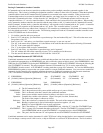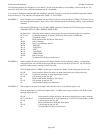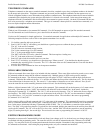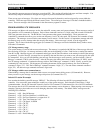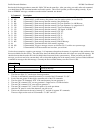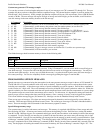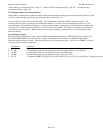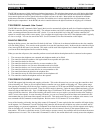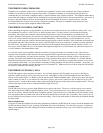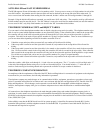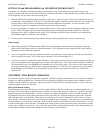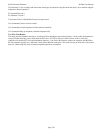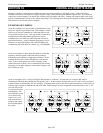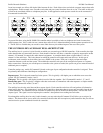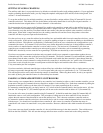
Pacific Research Solutions RI-300e User Manual
Page 115
SECTION 15 TELEPHONE INTERCONNECT
The RI-300 incorporates a highly intelligent telephone interconnect. This telephone interconnect uses a full duplex hybrid that
is balanced each time an outgoing call is started. A telephone hybrid is a circuit that divides the audio from the telephone line
into transmit signals and receive signals before those signals are sent to the radio. Most hybrids are adjusted for maximum
performance at the time of manufacturing. Over time, and with the use of various telephone lines, the performance of the
hybrid may be compromised. In the RI-300, the micro controller balances the hybrid each time an outgoing call is initiated.
TELEPHONE Automatic Gain Control
The RI-300 has an AGC (Automatic Gain Control) that is used to automatically adjust the audio level from the telephone line.
The micro controller directly controls this AGC. The software monitors and avoids conditions that would cause pumping of the
audio, a common problem with most other AGC circuits. You can set the initial level of the AGC and the controller will
operate in a smaller range of this coarse setting. You can adjust the overall range of the AGC if the telephone audio is typically
too low or too high. You can also turn off the AGC. See S-Command 79 for more information on this subject.
DIALING PROCESS
During the dialing process, the controller will check for dial tone. If dial tone is not detected within the set time, the controller
will start dialing anyway. You can also set the controller in an auto dial tone detect mode. In this mode, the controller will give
a busy message if the dial tone is not detected. This mode could be used if the telephone line is shared with someone else and
you want to check the telephone line for use before dialing.
When you start the call process, the controller performs several tasks before the telephone audio is connected to the repeater.
1. The user enters the telephone user command and telephone number to be dialed.
2. The controller checks the number to dial against both the accept table and reject table.
3. The controller checks for dial tone.
4. The controller checks the access table for an access number to dial.
5. The controller checks to see if an auto dial number needs to be dialed.
6. The controller checks to see if a user entered number needs to be dialed.
7. The controller checks the account table for an account number to dial.
8. The controller balances the hybrid to the telephone line.
9. The controller sets up all of the time-out timers for the telephone call.
10. The controller connects the telephone audio to the repeater.
TELEPHONE INCOMING CALLS
The RI-300 supports both incoming and outgoing call modes. This section discusses how you can set up the controller to deal
with an incoming call. There are several options that the controller can use to handle an incoming call. These options range
from ignoring an incoming call all the way up to requiring a password or CTCSS tone and DTMF sequence before the ring out
on the repeater transmitter can be executed. There are various modes in between. Under the most sophisticated mode, you can
selectively ring an individual radio. Up to 154,000 unique rings (154 different CTCSS tones / DCS codes and 3 digit DTMF
strings provide the selection). Most of the incoming call modes can be set up to require a password from the caller, limiting a
caller’s access to the repeater. In some incoming call modes, you can use a control password and then send commands in the
same manner that you would control the repeater over the radio. This mode would allow you to configure, write macros, issue
user commands and S-Commands over the telephone. Review section 12 S-Command 71 for more details.
In any of the incoming call modes, the ring delay counter (S-Command 75) must expire before the controller will begin ringing
on the repeater. In S-Command 71 modes 2 through 4 the controller will answer the call before any actions are taken, such as
repeater ringing or a password requirement. S-Command 76 can limit the total number of rings once the repeater starts ringing
from an incoming call. In mode 5, the controller will answer the call and connect it directly to the repeater without user
intervention. This mode is called auto answer. For this mode to operate correctly, the controller must be told where the answer
telephone macro is located. This is done with S-Command 32 event 19; the current default will correctly answer the telephone.



